|
 Depth Shifts
Depth Shifts
Logs run on separate passes can easily be off-depth from each
other. Choose one curve, usually the primary porosity curve (eg.
density or sonic or gamma ray), and make it the reference curve.
Compare all bed boundaries on each curve to the reference curve,
and build a table of depth adjustments over the interval to be
analyzed. Most computerized log analysis packages can stretch
or squeeze log curves based on such a table, or allow interactive
picking of the table from screen images.
Curves
that are run on the same pass can also be off depth with each
other. Some curves are memorized by the recording equipment because
they are actually recorded a few feet above the lowest curve on
the logging tool. The operator can set the memory distance incorrectly
or the electronic memorizer can malfunction. Even computer controlled
logging does not eliminate this problem.
Should
the logging tool pull tight in the hole, it may slow down or even
stop, while the cable keeps moving and stretching. Since the cable
movement drives the recording camera, curves will be recorded
off depth during this period. As a result of the memorizer, each
curve will be off depth at a different location on the log.
After
the tool pulls free it will move up the hole quickly while the
logging cable driving the recorder will not. Therefore, the logs
are again off depth, but in the opposite direction. This problem
can only be adequately resolved if a curve exists which did not
pull tight. Other curves can be stretched and squeezed to match
the reference curve by computer programs or by approximate depth
shift tables constructed by hand.
 Skips, Noise, and Spikes Skips, Noise, and Spikes
Cycle skips and noise are normally related to sonic logs, but
can occur on any log curve. To edit, draw a smooth log curve ignoring
the spikes, following an imaginary base log located beneath the
noise, as shown below.
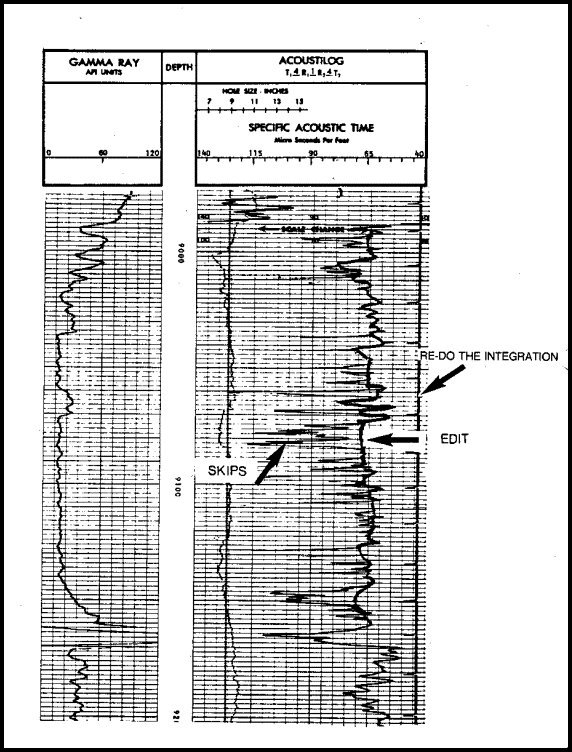
Editing sonic log skips
At
times, a smooth log curve may not exist. Therefore, it is necessary
to review an offset log or another curve from the same well. Note
that, the edit gives a sonic porosity of 5% - 10%
instead of 25%. It indicates a major difference and is more probable
for this particular zone.
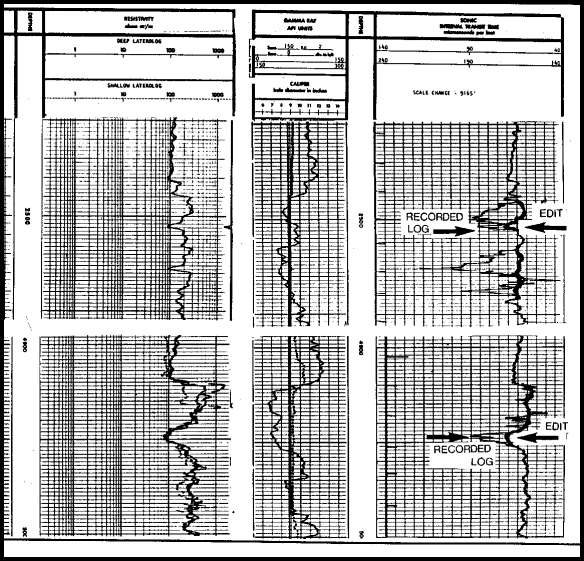
Editing density log for bad hole condition
CAUTION:
Some noise may be the result of thinly bedded porous layers, coal,
or rough hole effects. Coal spikes should be identified as such,
and bad hole effects discounted. Some bad hole is caused by breakout
of the wellbore at natural fractures. The density log is the most
strongly affected curve. The density log porosity should not be
used as an indicator of reservoir volume, but the location of
the fractures should be noted.
If
the sonic log is edited, the integrated transit time curve must
also be corrected.
 Rough, Large, and Salty Hole Effects Rough, Large, and Salty Hole Effects
All logs are affected to some degree by borehole size and environment.
Application of environmental corrections by computer programs
may reduce the need for editing. If no computer is handy, you
may have to do something yourself. Several examples are cited
here. The log below shows a resistivity log which is severely affected
by very conductive mud in the borehole. The dual laterolog would
have been more suitable in this instance. Since only the dual
induction was run, its readings must be used.
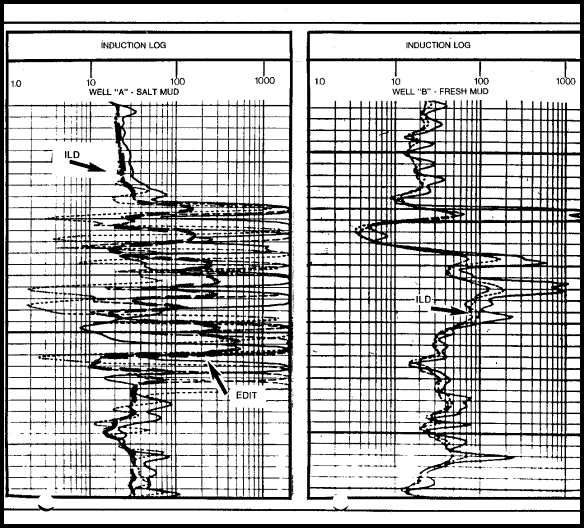
Dual Induction Log in salt mud (left), good log from offset well
(right)
As
a result two problems occur. Conductive mud causes the induction
log to read too low due to invasion and borehole effect. This
can be corrected by using special charts for invasion and borehole
corrections. These charts are unique to particular tool types
and can be obtained from service companies. Borehole correction
charts are available from each service company and may be incorporated
in computer aided log analysis programs. Since each tool from
each company requires its own individual correction chart, the
charts in the computer program may contain only a generic correction.
The
second problem is the hashy nature of the log in low porosity
zones, caused by variations in borehole effect. An edit is required
to select a reasonable resistivity value and is shown on the log.
The offset log, as well as the gamma ray, sonic and density neutron
curves are used to provide the proper amplitude and shape. This
is obviously a very serious change of log values and all calculated
results should be used with extreme caution.
CRAIN’S
OPINIONATED OPINION #1
|
Borehole
size, mud weight, and mud salinity corrections are
usually useful corrections to make.
Invasion
correction charts are almost universally useless.
The borehole and resistivity regime needed to satisfy
the available charts are almost never met in real
rocks. In particular, the published correction charts
are designed for mud filtrate invasion into water
zones and NOT for hydrocarbon bearing zones. Induction
log invasion corrections in a fresh mud system in
a hydrocarbon zone will reduce resistivity instead
of raising it. If a computer program has both environmental
and invasion corrections, leave the environment
corrections turned ON but the invasion corrections
turned OFF!
Borehole
corrections for gamma ray logs are useful. Corrections
for most neutron logs over-do the work and raise
porosity too much. Leave neutron corrections turned
OFF.
|
|
Modern
sonic logs are normally unaffected by hole size. At times, the
hole may be too large and the tool cannot find a refraction path
that will deliver sound to the receivers. The log may be edited
by comparison to offset wells, or reconstructed from calculations
based on other logs. Older style, single transmitter, sonic logs
have a spike at each change in hole size which must be edited
manually.
All
pad type devices, such as density, sidewall neutron, microlog,
proximity, and dipmeter logs are ineffective in large holes, where
the hole diameter is beyond the reach of the pad. Tools will either
read the mud value or jump from high to low values due to intermittent
contact with the borehole wall. Log data from these curves must
not be used in this environment.
In
holes ranging from bit size to approximately 30% of the pad extension,
the tool response is probably correct. From 30% to 90% extension,
logs may appear reasonable, but are influenced by mud between
the pad and borehole wall. A similar effect may arise in thick
mud cake where the hole size is smaller than the bit size.
Rough
or rugose holes will also leave excessive mud between the pad
and borehole wall. This effect may not seem too noticeable on
most logs, since the caliper may appear smooth. On the density
log, the correction curve will be abnormally high in such zones.
This problem cannot be detected on most other logs. Therefore,
caution is recommended. The MSFL does have an apparent mud cake
thickness curve (Hmc) which will be abnormally high in such conditions.
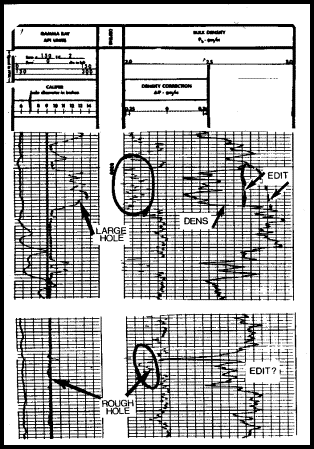
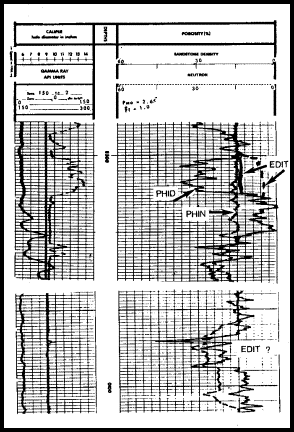
Density Logs in rough hole
We
know these logs are inaccurate because the apparent porosity is
too high compared to other sources of information such as the
sonic and offset wells. As well, the density neutron crossover
infers gas, yet this is not indicated by other logs or well data.
The porosity is abnormally high for a Devonian carbonate and the
density correction curve suggests caution. For reservoir evaluation,
the density data should be ignored. For seismic uses, an approximate
density would be estimated based on lithologic description and
offset well data.
|

